tyre pressure OPEL CORSA F 2020 Manual user
[x] Cancel search | Manufacturer: OPEL, Model Year: 2020, Model line: CORSA F, Model: OPEL CORSA F 2020Pages: 229, PDF Size: 21.14 MB
Page 186 of 229
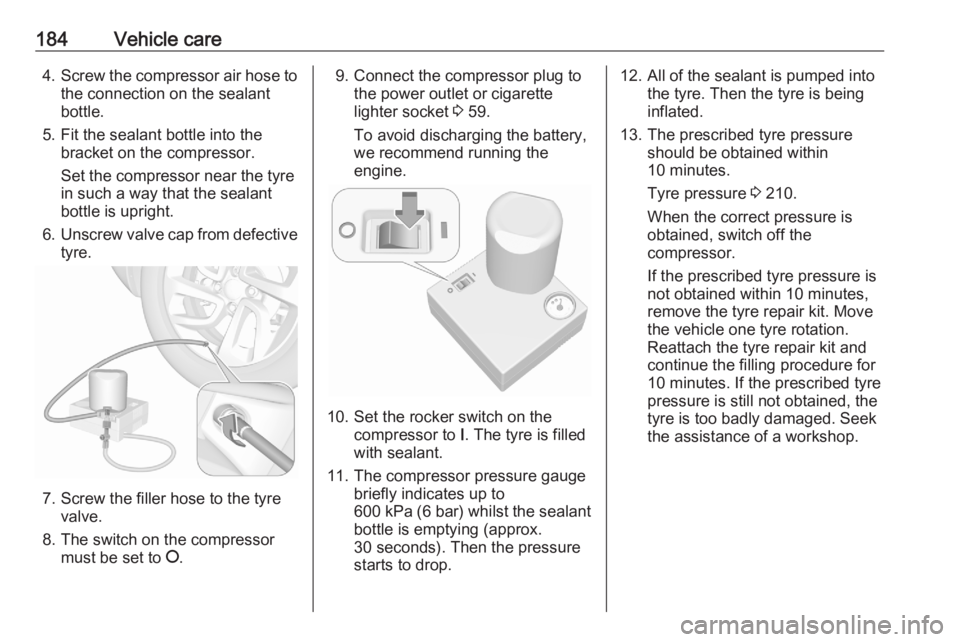
184Vehicle care4.Screw the compressor air hose to
the connection on the sealant
bottle.
5. Fit the sealant bottle into the bracket on the compressor.
Set the compressor near the tyre
in such a way that the sealant
bottle is upright.
6. Unscrew valve cap from defective
tyre.
7. Screw the filler hose to the tyre valve.
8. The switch on the compressor must be set to J.
9. Connect the compressor plug to
the power outlet or cigarette
lighter socket 3 59.
To avoid discharging the battery,
we recommend running the
engine.
10. Set the rocker switch on the compressor to I. The tyre is filled
with sealant.
11. The compressor pressure gauge briefly indicates up to
600 kPa (6 bar) whilst the sealant
bottle is emptying (approx.
30 seconds). Then the pressure
starts to drop.
12. All of the sealant is pumped into the tyre. Then the tyre is being
inflated.
13. The prescribed tyre pressure should be obtained within
10 minutes.
Tyre pressure 3 210.
When the correct pressure is
obtained, switch off the
compressor.
If the prescribed tyre pressure is
not obtained within 10 minutes,
remove the tyre repair kit. Move
the vehicle one tyre rotation.
Reattach the tyre repair kit and
continue the filling procedure for 10 minutes. If the prescribed tyre
pressure is still not obtained, the
tyre is too badly damaged. Seek
the assistance of a workshop.
Page 187 of 229
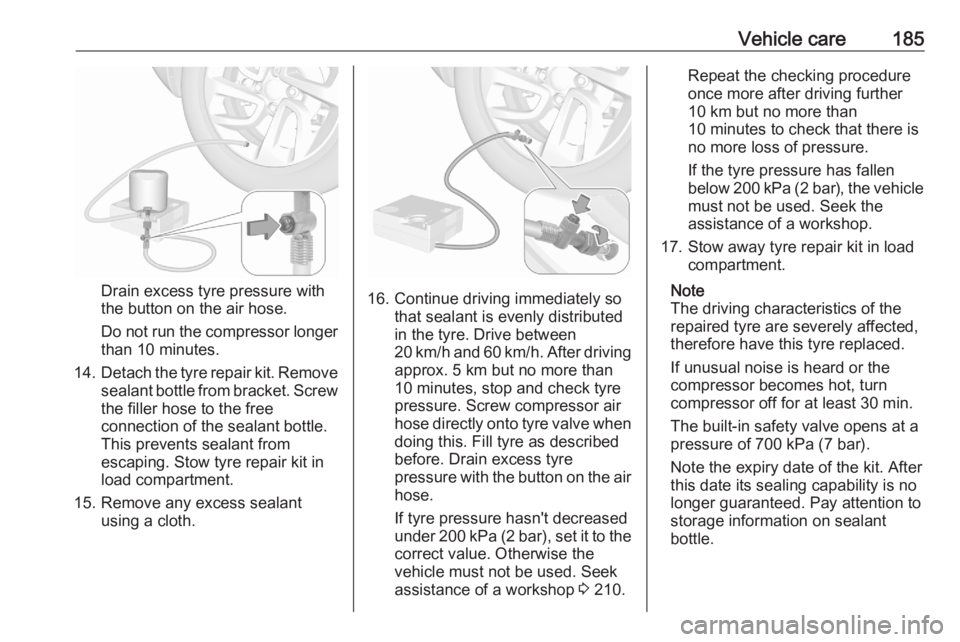
Vehicle care185
Drain excess tyre pressure with
the button on the air hose.
Do not run the compressor longer
than 10 minutes.
14. Detach the tyre repair kit. Remove
sealant bottle from bracket. Screw
the filler hose to the free connection of the sealant bottle.
This prevents sealant from
escaping. Stow tyre repair kit in
load compartment.
15. Remove any excess sealant using a cloth.16. Continue driving immediately sothat sealant is evenly distributed
in the tyre. Drive between
20 km/h and 60 km/h. After driving approx. 5 km but no more than
10 minutes, stop and check tyre
pressure. Screw compressor air
hose directly onto tyre valve when
doing this. Fill tyre as described
before. Drain excess tyre
pressure with the button on the air
hose.
If tyre pressure hasn't decreased
under 200 kPa (2 bar), set it to the
correct value. Otherwise the vehicle must not be used. Seek
assistance of a workshop 3 210.
Repeat the checking procedure
once more after driving further
10 km but no more than
10 minutes to check that there is
no more loss of pressure.
If the tyre pressure has fallen
below 200 kPa (2 bar), the vehicle must not be used. Seek the
assistance of a workshop.
17. Stow away tyre repair kit in load compartment.
Note
The driving characteristics of the
repaired tyre are severely affected,
therefore have this tyre replaced.
If unusual noise is heard or the
compressor becomes hot, turn
compressor off for at least 30 min.
The built-in safety valve opens at a
pressure of 700 kPa (7 bar).
Note the expiry date of the kit. After
this date its sealing capability is no
longer guaranteed. Pay attention to
storage information on sealant
bottle.
Page 192 of 229
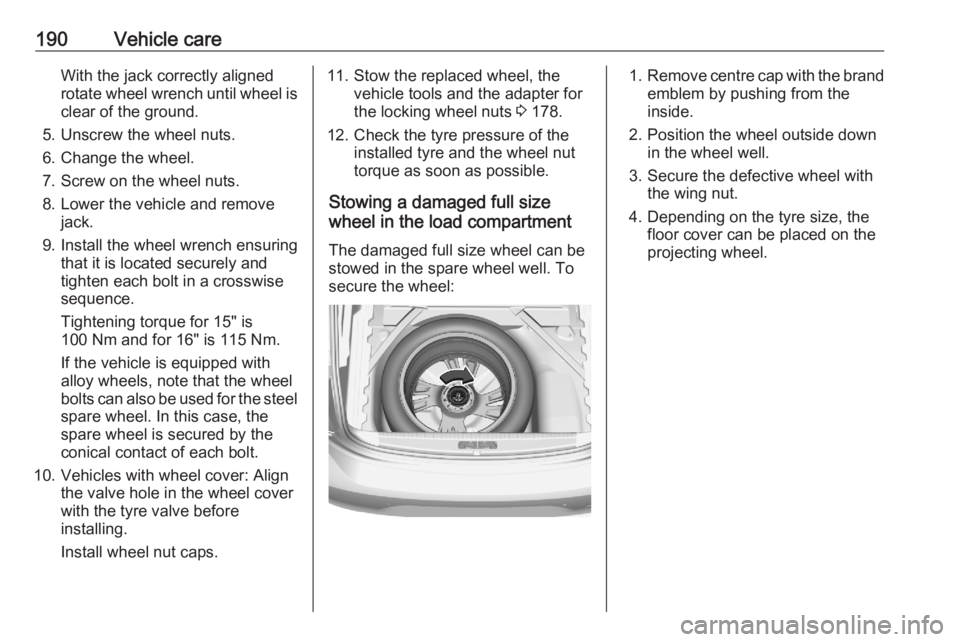
190Vehicle careWith the jack correctly aligned
rotate wheel wrench until wheel is
clear of the ground.
5. Unscrew the wheel nuts.
6. Change the wheel.
7. Screw on the wheel nuts.
8. Lower the vehicle and remove jack.
9. Install the wheel wrench ensuring that it is located securely and
tighten each bolt in a crosswise
sequence.
Tightening torque for 15" is
100 Nm and for 16" is 115 Nm.
If the vehicle is equipped with
alloy wheels, note that the wheel
bolts can also be used for the steel spare wheel. In this case, the
spare wheel is secured by the
conical contact of each bolt.
10. Vehicles with wheel cover: Align the valve hole in the wheel cover
with the tyre valve before
installing.
Install wheel nut caps.11. Stow the replaced wheel, the vehicle tools and the adapter forthe locking wheel nuts 3 178.
12. Check the tyre pressure of the installed tyre and the wheel nut
torque as soon as possible.
Stowing a damaged full size
wheel in the load compartment
The damaged full size wheel can be
stowed in the spare wheel well. To
secure the wheel:1. Remove centre cap with the brand
emblem by pushing from the
inside.
2. Position the wheel outside down in the wheel well.
3. Secure the defective wheel with the wing nut.
4. Depending on the tyre size, the floor cover can be placed on the
projecting wheel.
Page 197 of 229
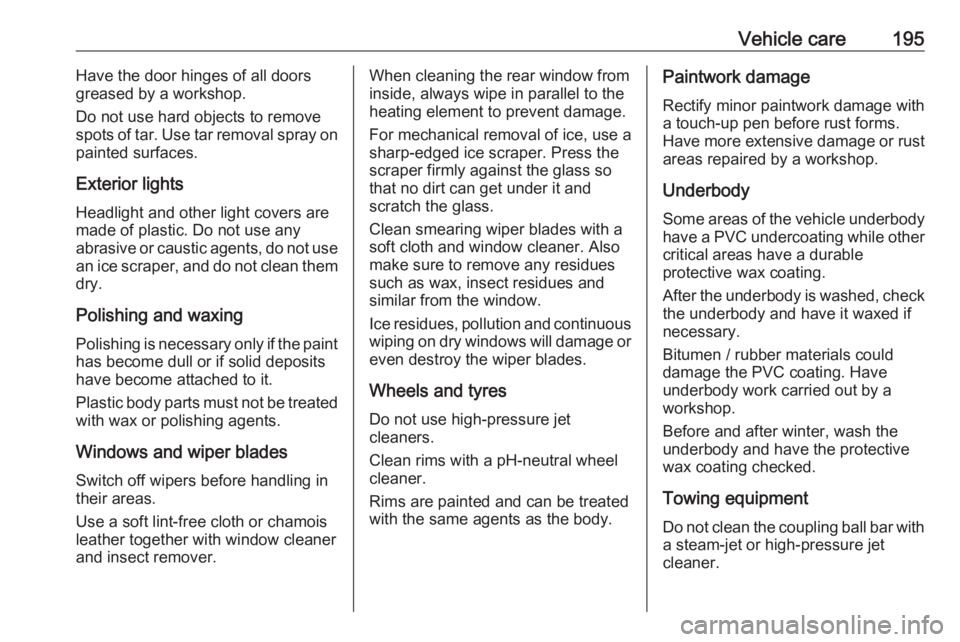
Vehicle care195Have the door hinges of all doors
greased by a workshop.
Do not use hard objects to remove
spots of tar. Use tar removal spray on
painted surfaces.
Exterior lights Headlight and other light covers are
made of plastic. Do not use any
abrasive or caustic agents, do not use
an ice scraper, and do not clean them
dry.
Polishing and waxing
Polishing is necessary only if the paint
has become dull or if solid deposits
have become attached to it.
Plastic body parts must not be treated with wax or polishing agents.
Windows and wiper blades Switch off wipers before handling in
their areas.
Use a soft lint-free cloth or chamois
leather together with window cleaner
and insect remover.When cleaning the rear window from
inside, always wipe in parallel to the
heating element to prevent damage.
For mechanical removal of ice, use a
sharp-edged ice scraper. Press the
scraper firmly against the glass so
that no dirt can get under it and
scratch the glass.
Clean smearing wiper blades with a
soft cloth and window cleaner. Also
make sure to remove any residues
such as wax, insect residues and
similar from the window.
Ice residues, pollution and continuous
wiping on dry windows will damage or even destroy the wiper blades.
Wheels and tyres
Do not use high-pressure jet
cleaners.
Clean rims with a pH-neutral wheel
cleaner.
Rims are painted and can be treated
with the same agents as the body.Paintwork damage
Rectify minor paintwork damage witha touch-up pen before rust forms.
Have more extensive damage or rust
areas repaired by a workshop.
Underbody Some areas of the vehicle underbody
have a PVC undercoating while other
critical areas have a durable
protective wax coating.
After the underbody is washed, check the underbody and have it waxed if
necessary.
Bitumen / rubber materials could damage the PVC coating. Have
underbody work carried out by a
workshop.
Before and after winter, wash the
underbody and have the protective
wax coating checked.
Towing equipment
Do not clean the coupling ball bar with
a steam-jet or high-pressure jet
cleaner.
Page 205 of 229
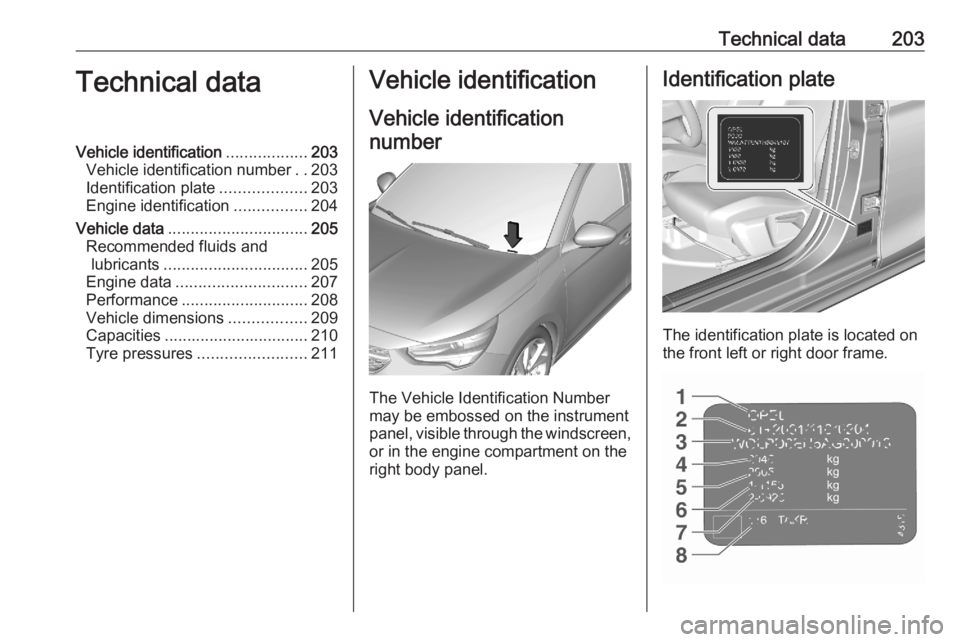
Technical data203Technical dataVehicle identification..................203
Vehicle identification number ..203
Identification plate ...................203
Engine identification ................204
Vehicle data ............................... 205
Recommended fluids and lubricants ................................ 205
Engine data ............................. 207
Performance ............................ 208
Vehicle dimensions .................209
Capacities ................................ 210
Tyre pressures ........................ 211Vehicle identification
Vehicle identificationnumber
The Vehicle Identification Number
may be embossed on the instrument
panel, visible through the windscreen, or in the engine compartment on the
right body panel.
Identification plate
The identification plate is located on
the front left or right door frame.
Page 213 of 229
![OPEL CORSA F 2020 Manual user Technical data211Tyre pressuresVehicle with up to 3 peopleWith full loadEngineTyresfrontrearfrontrear[kPa/bar] ([psi])[kPa/bar] ([psi])[kPa/bar] ([psi])[kPa/bar] ([psi])EB2FA185/65 R15,
195/55 R16,
20 OPEL CORSA F 2020 Manual user Technical data211Tyre pressuresVehicle with up to 3 peopleWith full loadEngineTyresfrontrearfrontrear[kPa/bar] ([psi])[kPa/bar] ([psi])[kPa/bar] ([psi])[kPa/bar] ([psi])EB2FA185/65 R15,
195/55 R16,
20](/img/37/18833/w960_18833-212.png)
Technical data211Tyre pressuresVehicle with up to 3 peopleWith full loadEngineTyresfrontrearfrontrear[kPa/bar] ([psi])[kPa/bar] ([psi])[kPa/bar] ([psi])[kPa/bar] ([psi])EB2FA185/65 R15,
195/55 R16,
205/45 R17
195/55 R16220/2.2 (32)210/2.1 (30)270/2.7 (39)290/2.9 (42)EB2ADTD,
EB2ADTS
DV5RD195/55 R16,
205/45 R17220/2.2 (32)210/2.1 (30)270/2.7 (39)290/2.9 (42)AllTemporary spare wheel 115/70 R15420/4.2 (60)420/4.2 (60)420/4.2 (60)420/4.2 (60)
Page 219 of 229

Customer information217Vehicle data recording
and privacy
Event data recorders Electronic control units are installed in
your vehicle. Control units process
data which is received by vehicle
sensors, for example, or which they
generate themselves or exchange
amongst themselves. Some control
units are necessary for the safe
functioning of your vehicle, others
assist you while you drive (driver
assistance systems), while others
provide comfort or infotainment
functions.
The following contains general
information about data processing in
the vehicle. You will find additional
information as to which specific data
is uploaded, stored and passed on to third parties and for what purpose in
your vehicle under the key word Data Protection closely linked to the
references for the affected functional
characteristics in the relevant owner's
manual or in the general terms of
sale. These are also available online.Operating data in the vehicle
Control units process data for
operation of the vehicle.
This data includes, for example: ● vehicle status information (e.g. speed, movement delay, lateral
acceleration, wheel rotation rate,
"seat belts fastened" display)
● ambient conditions (e.g. temperature, rain sensor,
distance sensor)
As a rule such data is transient and is not stored for longer than an
operational cycle, and only processed
on board the vehicle itself. Often
control units include data storage
(including the vehicle key). This is
used to allow information to be
documented temporarily or
permanently on vehicle condition,
component stress, maintenance
requirements and technical events
and errors.Depending on technical equipment
levels, the data stored is as follows:
● system component operating states (e.g. fill level, tyre
pressure, battery status)
● faults and defects in important system components (e.g. lights,
brakes)
● system reactions in special driving situations (e.g. triggeringof an airbag, actuation of the
stability control systems)
● information on events damaging the vehicle
● for electric vehicles the amount of
charge in the high-voltage
battery, estimated range
In special cases (e.g. if the vehicle
has detected a malfunction), it may be
necessary to save data that would
otherwise just be volatile.
When you use services (e.g. repairs,
maintenance), the operating data
saved can be read together with the
vehicle identification number and
used where necessary. Staff working
for the service network ( e.g. garages,
manufacturers) or third parties (e.g.
Page 222 of 229
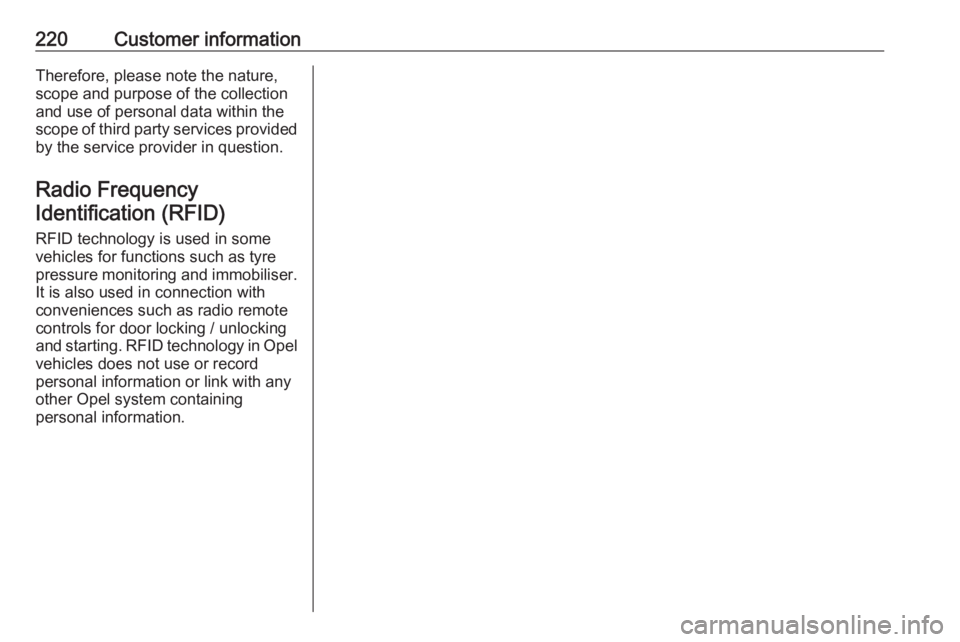
220Customer informationTherefore, please note the nature,
scope and purpose of the collection
and use of personal data within the
scope of third party services provided by the service provider in question.
Radio Frequency Identification (RFID)
RFID technology is used in some
vehicles for functions such as tyre
pressure monitoring and immobiliser.
It is also used in connection with
conveniences such as radio remote
controls for door locking / unlocking
and starting. RFID technology in Opel vehicles does not use or record
personal information or link with any other Opel system containing
personal information.
Page 227 of 229
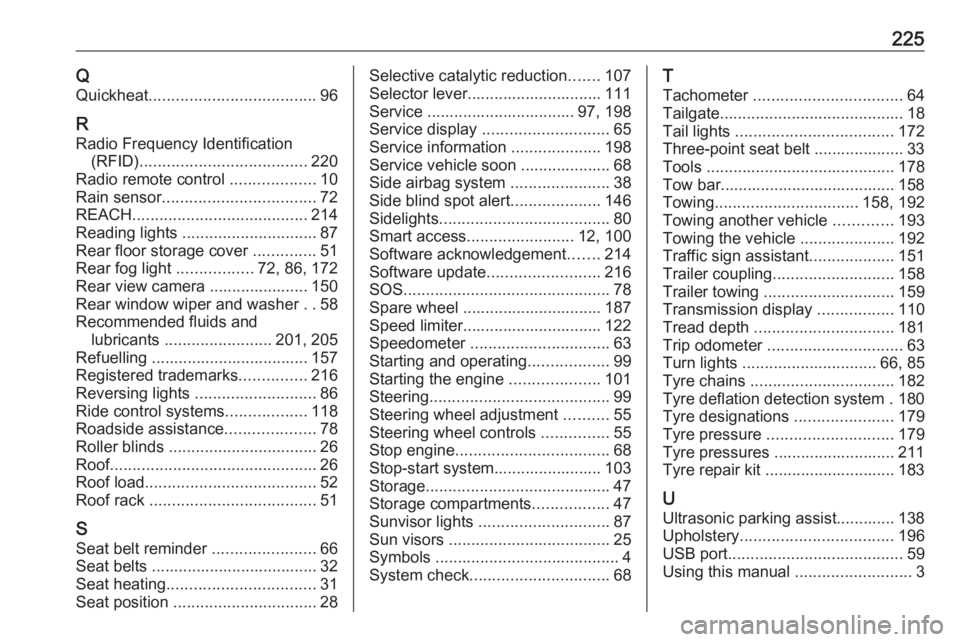
225QQuickheat ..................................... 96
R
Radio Frequency Identification (RFID) ..................................... 220
Radio remote control ...................10
Rain sensor .................................. 72
REACH ....................................... 214
Reading lights .............................. 87
Rear floor storage cover ..............51
Rear fog light .................72, 86, 172
Rear view camera ...................... 150
Rear window wiper and washer ..58
Recommended fluids and lubricants ........................ 201, 205
Refuelling ................................... 157
Registered trademarks ...............216
Reversing lights ........................... 86
Ride control systems ..................118
Roadside assistance ....................78
Roller blinds ................................. 26
Roof .............................................. 26
Roof load ...................................... 52
Roof rack ..................................... 51
S
Seat belt reminder .......................66
Seat belts ..................................... 32
Seat heating ................................. 31
Seat position ................................ 28Selective catalytic reduction .......107
Selector lever.............................. 111
Service ................................. 97, 198
Service display ............................ 65
Service information ....................198
Service vehicle soon .................... 68
Side airbag system ......................38
Side blind spot alert ....................146
Sidelights ...................................... 80
Smart access ........................ 12, 100
Software acknowledgement .......214
Software update ......................... 216
SOS .............................................. 78
Spare wheel ............................... 187
Speed limiter............................... 122
Speedometer ............................... 63
Starting and operating ..................99
Starting the engine ....................101
Steering ........................................ 99
Steering wheel adjustment ..........55
Steering wheel controls ...............55
Stop engine .................................. 68
Stop-start system........................ 103
Storage ......................................... 47
Storage compartments .................47
Sunvisor lights ............................. 87
Sun visors .................................... 25
Symbols ......................................... 4
System check ............................... 68T
Tachometer ................................. 64
Tailgate ......................................... 18
Tail lights ................................... 172
Three-point seat belt .................... 33 Tools .......................................... 178
Tow bar....................................... 158
Towing ................................ 158, 192
Towing another vehicle .............193
Towing the vehicle .....................192
Traffic sign assistant ...................151
Trailer coupling ........................... 158
Trailer towing ............................. 159
Transmission display .................110
Tread depth ............................... 181
Trip odometer .............................. 63
Turn lights .............................. 66, 85
Tyre chains ................................ 182
Tyre deflation detection system . 180
Tyre designations ......................179
Tyre pressure ............................ 179
Tyre pressures ........................... 211
Tyre repair kit ............................. 183
U
Ultrasonic parking assist............. 138
Upholstery .................................. 196
USB port ....................................... 59
Using this manual ..........................3